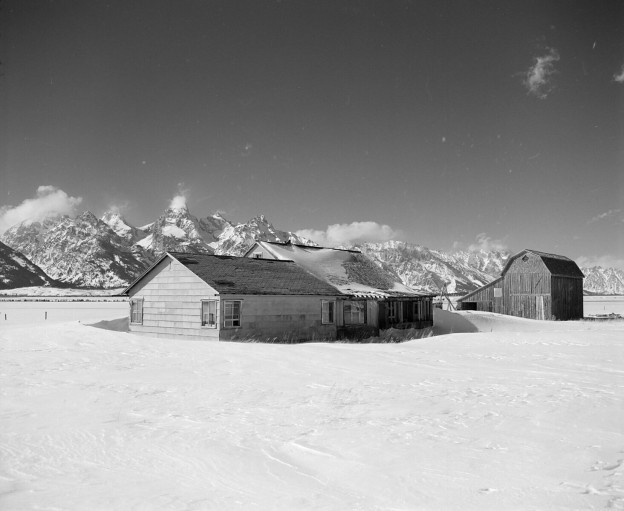In 1908, Thomas Murphy becomes one of the first men to settle on Mormon Row, traveling to the area with neighbors from Idaho, Thomas Alma and John Moulton. The community was officially called Grovont, and settled by 27 Mormon families. Their settlement in a Mormon “line village” gave them the nickname “Mormon Row” by their non-Mormon neighbors. The nickname stuck, and “Grovont” quickly faded into the past. Not much is known about Thomas Murphy, but he constructed the original portion of the house that now stands on what many call the Reed Moulton homestead. Murphy also constructed a small barn to shelter his horses, but it was later torn down and replaced. It is likely that Murphy dry farmed his land, having no direct access to water for irrigation. It is also probable that by 1920, when he sold his land to Joe Heninger, that the troubles of raising cattle and hay on just 160 acres, relying solely on rainfall became too much of a burden. Murphy’s location was farther north than his neighbors on Mormon Row and the soil was less fertile. His lands were open to the element and without the protection of Blacktail Butte. Whatever the reasons were, he vacated his land and moved on.
Joe Heninger lived on the property for the next two decades, surviving the Great Depression and drought that plagued the valley in the late 1920s. Those who were on Mormon Row greatly benefitted from the disastrous flood that destroyed Kelly and claimed six lives in 1927. The nearby Mud Springs (only good for mud) began producing water after the Kelly flood and became known as Miracle Springs. Today, it is known as Kelly Warm Spring. As the modern name suggests, the water it produced was warm so that the nearby homesteaders could make use of the spring year-round. In 1929 Heninger and his neighbors filed for water rights on Ditch Creek, which fed into the spring. They were successful and began construction of the Mormon Row Ditch, which irrigated five properties along the northern end of Mormon Row that had previously been dry farmed: Heninger, John Moulton, T. Alma Moulton, J.W. Moulton and Andy Chambers.
In 1945, likely feeling the pressure of recent valley developments, especially the 1943 creation of the Jackson Hole National Monument, and seeing little future prospects in maintaining his ranch, Heninger sold to neighbor John Moulton. Moulton then gave the ranch to his son, Reed. Reed and his wife Shirley lived on the property and helped John Moulton manage the ranch. By 1953, John sold both properties to the National Park Service after the 1950 expansion of Grand Teton National Park. Reed’s son Bob helped with the ranch work. The three generations of Moultons continued to live on the ranch until the early death of Reed in 1973. He was driving home from Driggs, Idaho with his wife, Shirley and their two daughters, Mary Ann and Debra when they hit a patch of ice on the road and were struck by an oncoming vehicle. Reed and Mary Ann did not survive the crash.
John and Bartha decided to move into Jackson, where they built a house. Bob chose to leave the valley, and left distant cousins to manage the ranch. In 1976, the last harvest on Mormon Row was completed. It wouldn’t be until 1990 that the National Park Service would acquire the land, with John Moulton’s death at 103 years old.
TIMELINE
1908: Thomas Murphy first enters Jackson Hole with neighbors Thomas Alma and John Moulton from Idaho. The three men file for adjacent claims along a small Mormon community that would become known as Mormon Row.
1915: Murphy receives the patent for his land.
1920: Joe Heninger purchases the Murphy homestead. He rebuilds the barn and expands the house.
1920-25: Heninger acquires the Jackson-Moran mail contract. He uses his large barn to house the mail trucks during the summer, and the horses and sleighs used in the winter.
1929: Heninger and his neighbors file a claim for water rights to Mud Springs (now Kelly Warm Springs) which began producing water after the 1927 Kelly flood. Successful, they construct the Mormon Row Ditch to irrigate their fields.
1945: John Moulton purchases the property and gives it to his son and daughter-in-law, Reed and Shirley. Reed helps his father run both ranches until his early death in 1973. It is probable that Heninger wanted to sell due to the recent drought and pressure from developments like the 1943 Jackson Hole National Monument. Hemmed in by Federal lands, Mormon Row residents were now unable to expand their holdings, unless they purchased from their neighbors.
1953: John Moulton sells his expanded property to the National Park Service after the 1950 expansion of Grand Teton National Park. He and his son Reed continue to live on the property. John later retires with his wife Bartha and builds a house in Jackson. Reed and his son, Bob continue to run the ranch on Mormon Row.
1973: Reed, his wife Shirley, their two daughters, Mary Ann and Debra are in a fatal car accident in Driggs, Idaho. Reed and Mary Ann, who was 13, do not survive the crash.
1990: John Moulton dies at 103 years old in Jackson, and his property transfers to National Park Service management.
Text by Samantha Ford, Director of Historical Research and Outreach




